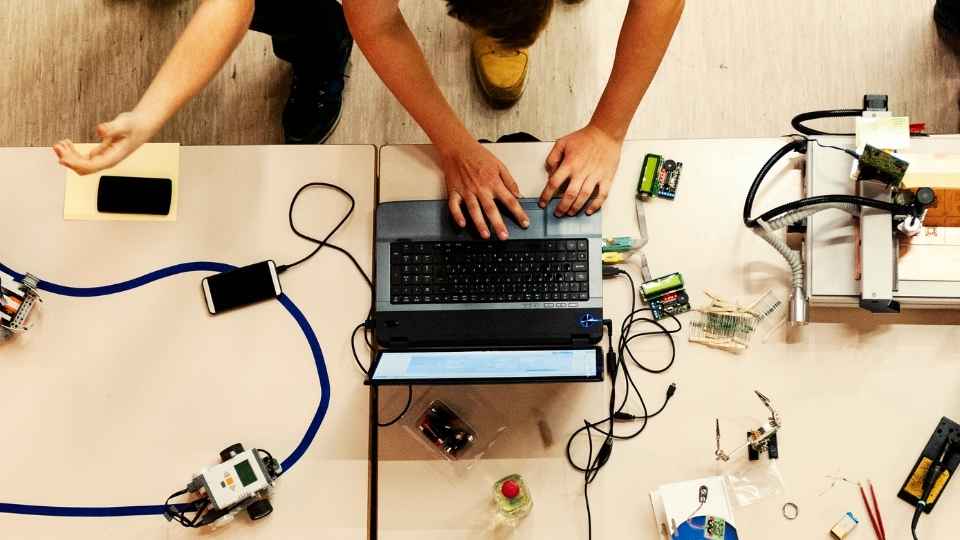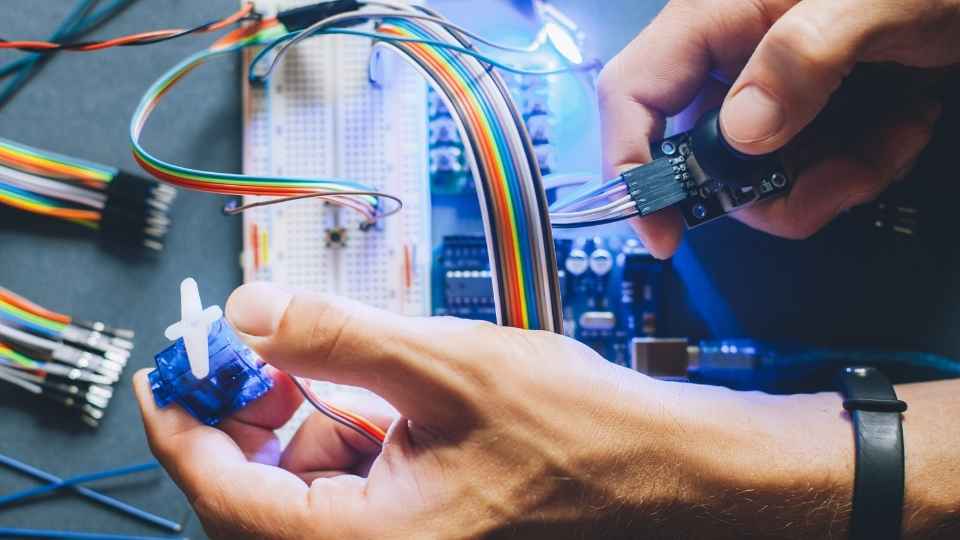
In a world where technological advancements continue to shape our future, the realm of robotics stands at the forefront of innovation.
As we embark upon the year 2023, it is with an air of irony that we ponder what lies ahead for robotic innovations. With each passing day, artificial intelligence grows more intelligent, automation becomes more efficient, and medical robotics push boundaries in unimaginable ways.
Join us as we delve into the exciting trends and possibilities that await us in this thrilling era of robotics.
Key Takeaways
- Advancements in artificial intelligence and machine learning are leading to more intelligent and capable robots, enabling autonomous decision-making and improved efficiency in various industries.
- Robotic automation and industrial robotics are reshaping industries through automation, integration of advanced technologies, and improved productivity and worker safety.
- Robotic prosthetics and medical robotics are transforming the lives of individuals with physical disabilities, offering enhanced functionality, improved surgical procedures, and expanded access to healthcare services.
- The rise of autonomous vehicles and drones is revolutionizing transportation, logistics, and various industries, reducing traffic congestion, enhancing convenience, and enabling new possibilities in delivery services and emergency response.
Advancements in Artificial Intelligence and Machine Learning
Advancements in artificial intelligence and machine learning are poised to greatly impact the field of robotics in 2023. As these technologies continue to evolve at an exponential rate, robots will become more intelligent, adaptable, and capable.
Machine learning algorithms will enable robots to learn from their experiences and make autonomous decisions based on real-time data analysis. This will lead to enhanced problem-solving abilities, improved efficiency, and increased productivity in various industries such as manufacturing, healthcare, and logistics.
Additionally, advancements in AI will empower robots to understand human emotions and intentions better, enabling them to interact with humans more effectively.
The integration of AI and machine learning into robotics is a significant step towards creating a future where robots can seamlessly coexist with humans while performing complex tasks autonomously.

Breakthroughs in Robotic Automation and Industrial Robotics
Significant progress has been made in the realm of automating industrial processes, with notable developments in robotic automation that are reshaping various industries.
The integration of advanced technologies such as artificial intelligence and machine learning has enabled robots to perform complex tasks with precision and efficiency. Industrial robots are now equipped with sophisticated sensors and algorithms, allowing them to adapt to changing environments and collaborate seamlessly with human workers.
This enhanced level of automation not only improves productivity but also ensures worker safety by taking over hazardous or repetitive tasks. As we look ahead to 2023, the advancements in robotic automation are set to revolutionize industries further, enabling more streamlined operations, increased flexibility, and cost savings.
These breakthroughs pave the way for even more exciting innovations in robotic prosthetics and medical robotics, where robots can enhance mobility and provide better healthcare solutions for individuals in need.
Innovations in Robotic Prosthetics and Medical Robotics
The integration of advanced technologies in the field of prosthetics and medical robotics has resulted in groundbreaking developments that are transforming the lives of individuals with physical disabilities. These innovations are driven by a desire to provide freedom and independence for those who have lost limbs or suffer from mobility impairments.
Today, robotic prosthetics offer enhanced functionality and natural movement, allowing users to engage in activities they once thought were impossible.
Advancements in medical robotics have also led to significant improvements in surgical procedures. Robots equipped with precise instruments and imaging systems enable surgeons to perform complex surgeries with greater accuracy, minimizing invasiveness and recovery time for patients.

Furthermore, telemedicine has expanded access to healthcare services, particularly for those living in remote areas or facing mobility challenges.
As we move forward into an era of unprecedented technological advancements, the possibilities for robotic prosthetics and medical robotics are limitless. The continued collaboration between engineers, scientists, and medical professionals holds great promise for creating a future where physical disabilities no longer limit one's ability to live a full and independent life.
The Rise of Autonomous Vehicles and Drones
Autonomous vehicles and drones are revolutionizing transportation and logistics by offering efficient and innovative solutions for various industries. These advanced technologies have the potential to transform the way we move goods and people, making transportation faster, safer, and more sustainable.
With autonomous vehicles, we can envision a future where traffic congestion is reduced, accidents are minimized, and travel becomes more convenient.
Drones, on the other hand, are enabling new possibilities in fields such as delivery services, aerial photography, and emergency response. They can navigate through challenging terrains or reach remote areas that were previously inaccessible.
As these technologies continue to evolve and become more sophisticated, they hold the promise of reshaping our cities' infrastructure and redefining our concept of mobility.
Looking ahead to new frontiers in space robotics and exploration...

New Frontiers in Space Robotics and Exploration
Space exploration is entering a new era as advancements in technology allow for the development of groundbreaking missions and discoveries. The future of space robotics and exploration holds immense potential, with several exciting developments on the horizon:
Enhanced Robotic Arms:
Next-generation robotic arms equipped with advanced sensors and AI capabilities will enable precise manipulation and assembly tasks in space. These arms will be capable of intricate repairs on spacecraft, satellites, or even planetary habitats.
Autonomous Rovers:
Advanced autonomous rovers will navigate distant planets and moons to collect samples, conduct experiments, and search for signs of life. These rovers will possess improved mobility, communication systems, and sample analysis capabilities.
Space Mining Robots:
Robots designed for mining operations in space will extract valuable resources from asteroids or lunar surfaces to support future human colonies. These robots will utilize innovative drilling technologies and automated resource processing systems.
As we push the boundaries of space exploration, these advancements in robotics promise to unlock new frontiers and pave the way for a more prosperous future beyond Earth's confines.
Frequently Asked Questions
How Will Advancements in Artificial Intelligence and Machine Learning Impact Job Opportunities in the Robotics Industry?
Advancements in artificial intelligence and machine learning will significantly impact job opportunities in the robotics industry. The integration of these technologies will automate repetitive tasks, create new roles focused on programming and maintenance, and require workers to upskill in order to remain relevant.
What Are the Primary Challenges Faced in Implementing Robotic Automation in Industries?
The primary challenges faced in implementing robotic automation in industries include high upfront costs, lack of skilled workers to operate and maintain robots, and the need for integration with existing infrastructure. These challenges must be addressed to fully harness the potential of robotics.

How Do Innovations in Robotic Prosthetics Contribute to Improving the Quality of Life for Individuals With Disabilities?
Innovations in robotic prosthetics play a crucial role in enhancing the quality of life for individuals with disabilities. These advancements provide increased mobility, functionality, and independence, enabling them to engage more fully in daily activities and participate actively in society.
What Are the Potential Risks and Benefits Associated With the Rise of Autonomous Vehicles and Drones?
The rise of autonomous vehicles and drones brings both risks and benefits. Potential risks include safety concerns, security threats, and job displacement. However, the potential benefits include improved transportation efficiency, reduced traffic congestion, and increased accessibility to remote areas.
How Are Space Robotics and Exploration Contributing to Advancements in Scientific Research and Space Exploration?
Space robotics and exploration are driving advancements in scientific research and space exploration. These technologies enable the collection of data from remote locations, enhance our understanding of celestial bodies, and pave the way for future manned missions to explore the cosmos.
 Basic Electronics ConceptsEssential ToolsCircuit Design BasicsMicrocontrollersDIY Electronics ProjectsRoboticsPrivacy PolicyTerms And Conditions
Basic Electronics ConceptsEssential ToolsCircuit Design BasicsMicrocontrollersDIY Electronics ProjectsRoboticsPrivacy PolicyTerms And Conditions
